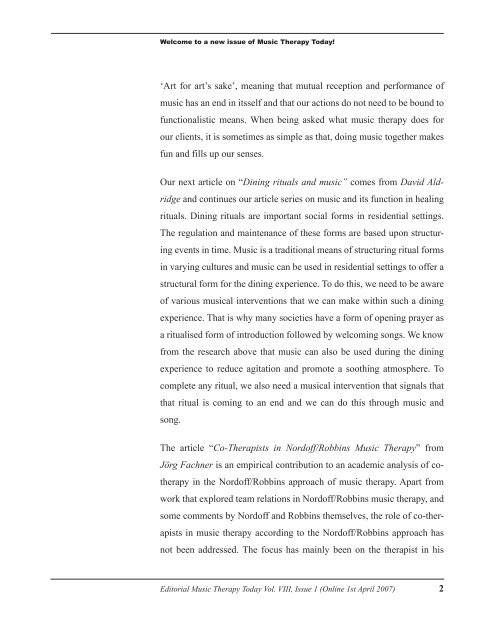Music Therapy Today - World Federation of Music Therapy
Music Therapy Today - World Federation of Music Therapy
Music Therapy Today - World Federation of Music Therapy
Create successful ePaper yourself
Turn your PDF publications into a flip-book with our unique Google optimized e-Paper software.
Welcome to a new issue <strong>of</strong> <strong>Music</strong> <strong>Therapy</strong> <strong>Today</strong>!<br />
‘Art for art’s sake’, meaning that mutual reception and performance <strong>of</strong><br />
music has an end in itsself and that our actions do not need to be bound to<br />
functionalistic means. When being asked what music therapy does for<br />
our clients, it is sometimes as simple as that, doing music together makes<br />
fun and fills up our senses.<br />
Our next article on “ Dining rituals and music” comes from David Ald-<br />
ridge and continues our article series on music and its function in healing<br />
rituals. Dining rituals are important social forms in residential settings.<br />
The regulation and maintenance <strong>of</strong> these forms are based upon structur-<br />
ing events in time. <strong>Music</strong> is a traditional means <strong>of</strong> structuring ritual forms<br />
in varying cultures and music can be used in residential settings to <strong>of</strong>fer a<br />
structural form for the dining experience. To do this, we need to be aware<br />
<strong>of</strong> various musical interventions that we can make within such a dining<br />
experience. That is why many societies have a form <strong>of</strong> opening prayer as<br />
a ritualised form <strong>of</strong> introduction followed by welcoming songs. We know<br />
from the research above that music can also be used during the dining<br />
experience to reduce agitation and promote a soothing atmosphere. To<br />
complete any ritual, we also need a musical intervention that signals that<br />
that ritual is coming to an end and we can do this through music and<br />
song.<br />
The article “ Co-Therapists in Nord<strong>of</strong>f/Robbins <strong>Music</strong> <strong>Therapy</strong>”<br />
from<br />
Jörg Fachner is an empirical contribution to an academic analysis <strong>of</strong> co-<br />
therapy in the Nord<strong>of</strong>f/Robbins approach <strong>of</strong> music therapy. Apart from<br />
work that explored team relations in Nord<strong>of</strong>f/Robbins music therapy, and<br />
some comments by Nord<strong>of</strong>f and Robbins themselves, the role <strong>of</strong> co-ther-<br />
apists in music therapy according to the Nord<strong>of</strong>f/Robbins approach has<br />
not been addressed. The focus has mainly been on the therapist in his<br />
Editorial <strong>Music</strong> <strong>Therapy</strong> <strong>Today</strong> Vol. VIII, Issue 1 (Online 1st April 2007)<br />
2

















